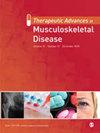Impact of daily physical therapy over 2 weeks on spinal mobility including objective electronic measurements and function in patients with axial spondyloarthritis
IF 3.4
2区 医学
Q2 RHEUMATOLOGY
引用次数: 0
Abstract
Background:Patients with axial spondyloarthritis (axSpA) are often compromised by impaired function and mobility. The standardized 2-week inpatient program ‘multimodal rheumatologic complex treatment’ (MRCT) was designed for patients with axSpA. The Epionics SPINE (ES) is an objective tool validated to assess mobility.Objective:To investigate the impact of MRCT on physical function and mobility including range of motion (RoM) and kinematics (RoK).Design:Single-center interventional, observational trial.Methods:Patients with axSpA presenting with high disease activity and impaired physical function were consecutively recruited to undergo MRCT. Assessments performed before (V1) and after (V2) the intervention included Bath Ankylosing Spondylitis Disease Activity Index (BASDAI), Bath Ankylosing Spondylitis functional index (BASFI), Bath Ankylosing Spondylitis Metrology Index (BASMI), the ankylosing spondylitis physical performance index (ASPI), the Short Physical Performance Battery (SPPB), and ES measurements.Results:At baseline, the 80 patients included had: BASDAI 5.5 ± 1.5, BASFI 5.6 ± 2.0, BASMI 4.2 ± 1.8, SPPB 13.8 ± 1.8, and ASPI 37.3 ± 18.1 s. Clinically relevant improvements between V1 versus V2 were noted for BASFI, BASMI, and all other assessments ( p < 0.001), and also for ES measures of RoK (all p < 0.003) and RoM (all p < 0.04), while a positive trend was seen for flexion and extension (RoM). There was no significant effect of changes in medication (all p > 0.05).Conclusion:The 2-weeks MRCT was associated with definite improvements of function and mobility. Importantly, the effect of this extensive physical activity was confirmed by using the ES as an objective tool to assess spinal mobility. The ES demonstrated for the first time that the RoK of spinal mobility can significantly improve related to an exercise intervention.Trial registration:Ethical Committee: Ruhr-Universität (reference-number: 19-6735-BR).为期两周的日常物理治疗对轴向脊柱关节炎患者脊柱活动度(包括客观电子测量值)和功能的影响
背景:轴性脊柱关节炎(axSpA)患者通常功能受损,行动不便。针对轴性脊柱关节炎患者设计了为期两周的标准化住院项目 "多模式风湿病综合治疗"(MRCT)。目的:研究MRCT对身体功能和活动能力的影响,包括运动范围(RoM)和运动学(RoK)。方法:连续招募疾病活动度高、身体功能受损的轴性SpA患者接受MRCT治疗。干预前(V1)和干预后(V2)进行的评估包括巴斯强直性脊柱炎疾病活动指数(BASDAI)、巴斯强直性脊柱炎功能指数(BASFI)、巴斯强直性脊柱炎计量指数(BASMI)、强直性脊柱炎体能指数(ASPI)、短期体能测试(SPPB)和ES测量:BASDAI 5.5 ± 1.5、BASFI 5.6 ± 2.0、BASMI 4.2 ± 1.8、SPPB 13.8 ± 1.8、ASPI 37.3 ± 18.1 秒。在 BASFI、BASMI 和所有其他评估(p < 0.001)以及 ES 测量 RoK(所有 p < 0.003)和 RoM(所有 p < 0.04)方面,V1 与 V2 之间存在临床相关性改善,而在屈伸(RoM)方面则出现了积极趋势。结论:为期 2 周的 MRCT 可明显改善患者的功能和活动能力。重要的是,使用 ES 作为评估脊柱活动度的客观工具,证实了这种广泛的体育锻炼的效果。ES首次证明,脊柱活动度RoK可在运动干预后得到显著改善:试验注册:伦理委员会:鲁尔大学(参考编号:19-6735-BR)。
本文章由计算机程序翻译,如有差异,请以英文原文为准。
求助全文
约1分钟内获得全文
求助全文
来源期刊

Therapeutic Advances in Musculoskeletal Disease
Medicine-Rheumatology
CiteScore
6.80
自引率
4.80%
发文量
132
审稿时长
18 weeks
期刊介绍:
Therapeutic Advances in Musculoskeletal Disease delivers the highest quality peer-reviewed articles, reviews, and scholarly comment on pioneering efforts and innovative studies across all areas of musculoskeletal disease.
 求助内容:
求助内容: 应助结果提醒方式:
应助结果提醒方式:


